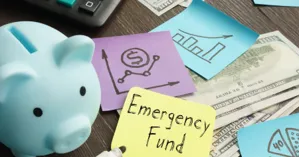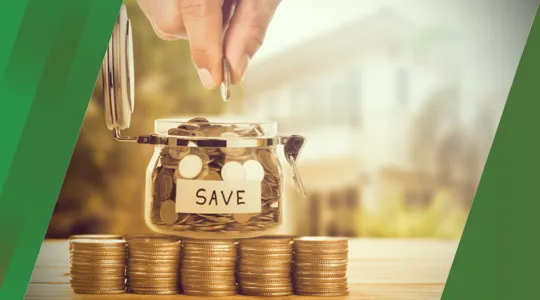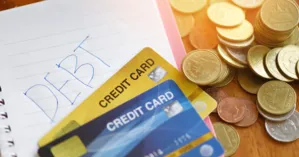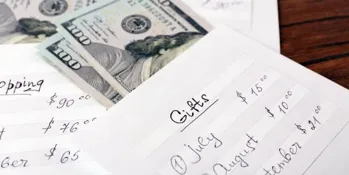- Quick Summary
- What is an Emergency Fund?
- Why is an Emergency Fund Important for Unplanned Expenses?
- Benefits of Having an Emergency Fund
- How Much Do You Save in an Emergency Fund for Living Expenses?
- Where Should You Keep Your Emergency Fund: High Yield Savings Account
- Setting Up Your Emergency Fund Account
- Steps to Building an Emergency Fund
- Balance Debt and Emergency Funds
- Conclusion

- Quick Summary
- What is an Emergency Fund?
- Why is an Emergency Fund Important for Unplanned Expenses?
- Benefits of Having an Emergency Fund
- How Much Do You Save in an Emergency Fund for Living Expenses?
- Where Should You Keep Your Emergency Fund: High Yield Savings Account
- Setting Up Your Emergency Fund Account
- Steps to Building an Emergency Fund
- Balance Debt and Emergency Funds
- Conclusion
What if your car broke down, and it was a $2,100 repair bill? Or worse, what if you suddenly get laid off from your job? How will you make ends meet? Having a backup plan is essential, and that’s what an emergency fund is. But how do you go about creating one? Here’s a how-to guide on how to build an emergency fund.
What is an Emergency Fund?

An emergency fund is a pool of money set aside specifically to cover unexpected expenses, such as medical bills, car repairs, or a sudden loss of income. Think of it as a financial cushion that provides peace of mind and stability when life throws you a curveball. By having an emergency fund, you can avoid the stress and financial strain of relying on high-interest credit cards or loans, which can quickly lead to debt and financial difficulties. In essence, an emergency fund is your safety net for life’s unplanned expenses, ensuring you can handle emergencies without derailing your financial goals.
Why is an Emergency Fund Important for Unplanned Expenses?
Because an emergency fund can pay for unexpected expenses, it helps you avoid debt. You won’t be tempted to add to your credit card balance or take out a loan.
Many people feel anxious because they don’t have emergency funds. In fact, more than half of Americans are uncomfortable with their savings. Two-thirds worry that they won’t be able to pay their expenses for a month, let alone long-term.
It’s imperative you have an emergency fund. No one is safe from emergencies.
Benefits of Having an Emergency Fund
Having an emergency fund offers numerous benefits that can significantly improve your financial well-being. Firstly, it provides financial stability and peace of mind, knowing you have a buffer to fall back on in case of unexpected expenses. This protection helps you avoid high-interest debt and the financial difficulties that come with it. Additionally, an emergency fund ensures you can cover essential living expenses, such as rent, utilities, and groceries, in case of job loss or reduced income. This financial cushion allows you to focus on long-term goals, like saving for retirement or a down payment on a house, without the constant worry of financial emergencies. In short, an emergency fund is a crucial financial safety net that helps you navigate life’s uncertainties with confidence.
How Much Do You Save in an Emergency Fund for Living Expenses?
What should your emergency fund be worth? Does it need to be a certain amount of monthly paychecks?
An emergency fund savings doesn’t necessarily have to be your monthly paycheck amount. It needs to cover your monthly expenses. The rule of thumb is three to six months.
Monthly expenses include:
- food
- transportation
- rent
- credit card payments
- loan payments
For example, if your monthly expenses are $5,000 a month but your paycheck is $6,000, you only need to save $15,000 for three months. The extra three don’t need to be saved. In other words, we’re talking about covering expenses not income.
So, the emergency fund’s amount is dependent on everyone’s situation. There’s no hard, fast rule.
Where Should You Keep Your Emergency Fund: High Yield Savings Account

Of course, you shouldn’t keep it under the bed, but there’s another place to avoid keeping your emergency fund: certain types of bank accounts.
Never keep your emergency fund in your checking account. It’s too accessible for you. You’ll be tempted to dip into it whenever you’re short on cash and want to buy something. So, instead of saving $100, you’ve blown it on a pair of shoes.
Instead, deposit your savings in an emergency savings account that is a little more difficult to access.
You’ll want a high-yield account as well. The average traditional bank has a .45 percent interest rate, according to the Federal Deposit Insurance Corporation (FDIC). But a high-yield savings or money market account to park your money for a while.
Online banks tend to have high-yield interest rates. Their interest rates can be as high as six percent. For example, some online banks with high-yield accounts are:
- SoFi – 4.60%
- EverBank – 5.05%
- Barclays – 4.80%
Your funds are accessible with online banks but not so accessible that you’ll be dipping into them. The online banks can be linked to your traditional account so you can transfer money to them.
A great option is a Money Market account. These work like savings and checking accounts. The difference is that you only have a limited number of transactions per month. You can put as much money as you want at any time, but you can’t take it out consistently. Most will allow six withdrawals per month.
You’ll also receive high-yield rates when you open a Money Market with an online bank.
Setting Up Your Emergency Fund Account
Setting up your emergency fund account is a straightforward process that can provide you with a crucial financial safety net. Here are the steps to get started:
- Choose a Savings Account: Opt for a high-yield savings account or a money market account. These accounts offer easy access to your funds while earning interest, helping your emergency savings grow over time.
- Determine Your Savings Goal: Aim to save 3-6 months’ worth of living expenses. This amount will vary based on your individual financial situation, but it’s a good rule of thumb to ensure you have enough to cover essential costs.
- Set Up Direct Deposit: Arrange for automatic transfers from your checking account to your emergency fund account. This makes saving effortless and ensures you consistently contribute to your fund.
- Automate Your Savings: Set up recurring transfers to your emergency fund account. Automation helps you stay on track with your savings goals without having to remember to make manual transfers.
- Monitor and Adjust: Regularly review your emergency fund account to ensure it’s on track to meet your savings goal. Make adjustments as needed to stay aligned with your financial objectives.
Remember to keep your emergency fund account separate from your everyday checking and savings accounts. This separation helps you avoid the temptation to dip into your emergency savings for non-essential expenses. By following these steps, you can establish a crucial financial safety net that provides peace of mind and financial stability in times of need.
Steps to Building an Emergency Fund
Building an emergency savings fund will take dedication and discipline. But you don’t have to do it overnight. Here are some steps to setting up your fund and giving your life a financial cushion against disaster.
Create a Budget
Once you have determined how much you need in your emergency fund, create a budget. That’s the only way to determine what you can afford to sock away each month.
You can’t save if you don’t know what dollar amount you have extra each month. Or if you’re always short at the end of the month, a budget will show you expenses so you’ll know which you can reduce or cut.
There are budgeting apps like Monarch or Quicken to help you get started.
Even if you just need to go old school and use pencil and paper, you can still write down your income versus your expenses and figure out how much you can save each month.
Set Small Goals
In the beginning, don't look at the overall goal. Your goal might be six months, but concentrate on saving for one. Once you have the one month covered, shoot for two months, and so on.
It will take much of the pressure off you if you break it down.
Start Saving in Small Chunks
Even if it's only ten dollars a week initially, it's better than nothing. Just make sure you deposit the money on a regular basis. This will get you into the habit of saving. And that’s half the battle. Online banks don’t have a minimum deposit, so you can start small and still earn high interest.
Once your income increases, add to the amount you deposit into the emergency fund each week.
Save Your Windfalls
A windfall is an unexpected influx of cash. This might be a tax refund, a bonus or an inheritance. Make it a point to save some or all of it in your emergency fund. Most people spend the whole chunk on something fun. And it's ok to have fun as long as you put some of it away first.
Automate Your Saving
If your employer offers direct deposit, ask if they can divide an amount between checking and savings. This will achieve your monthly goal without you having to do anything.
Save the Change
There are savings-focused apps, like Acorns and Qapital, that link with investing accounts to round up purchase amounts when you purchases an item or service. The extra amount is transferred to your account. This adds up quickly, and you won't even notice that you're saving.
Monitor Your Progress
Keep yourself motivated by checking your progress periodically. Checking quarterly is usually a good number, so you can see a big jump. Watching your progress offers gratification and the necessary push to carry on with your savings plan.
Reassess Periodically
Don't be the victim of lifestyle inflation. In other words, don't increase your expenses just because your income increases. Don't get that bigger, more expensive apartment or house. Instead, increase the amount of money you deposit into your savings or Money Market accounts.
Watch Over-Saving
Once you’ve met your emergency fund goal, consider switching your efforts to a retirement plan or downpayment for a house. You could also invest your money in bonds or stocks. Consult with a financial advisor to see what’s best for your situation.
Replenish Emergency Fund
There usually isn't one unexpected expense. Emergencies happen continuously. If you dip into your fund to pay for that car repair or busted water pipe, ensure you replace the money. You want to keep that fund at its original goal as much as possible.
Balance Debt and Emergency Funds

If you have high-interest credit card balances or loans, be sure to concentrate on paying them off and saving.
It's important to cover emergencies, but debt costs you a lot of money. Eliminating your debt will reduce the number of expenses you have to plan for.
Consider starting a small emergency fund and mainly concentrating on paying off your high-interest debt.
Conclusion
Life can throw curve balls even for those who haven't had unexpected expenses. It's best to have a cushion in the event of a layoff or emergency expense.





